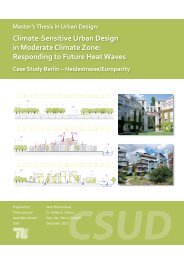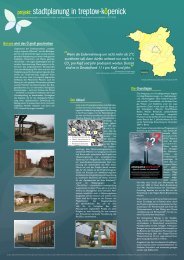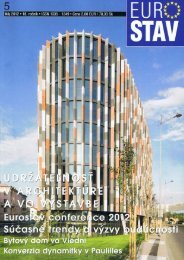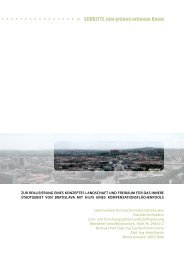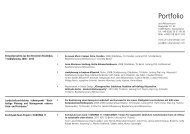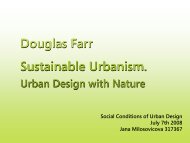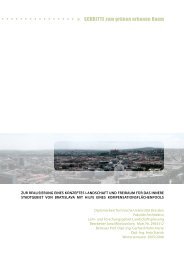Bausteine - Referate - Jana Milosovicova - Urban Design English
Bausteine - Referate - Jana Milosovicova - Urban Design English
Bausteine - Referate - Jana Milosovicova - Urban Design English
Erfolgreiche ePaper selbst erstellen
Machen Sie aus Ihren PDF Publikationen ein blätterbares Flipbook mit unserer einzigartigen Google optimierten e-Paper Software.
documentation of LEED-ND.<br />
Points vs. Grades<br />
By using a generalized analysis, the results of the<br />
Assessment Matrix are more subjective whereas<br />
LEED-ND draws a bright line between what<br />
achieves a point and what is not based on a specific<br />
calculation. The Assessment Matrix allows<br />
for more professional judgment in the rating<br />
process however without more specific criteria<br />
in some areas, it would be difficult to implement<br />
in a certification process. The advantage to the<br />
Assessment Matrix approach is that is rates all<br />
criteria, giving poor notes to areas that do not<br />
meet the rating system goals and also allowing<br />
for a gradation between good and bad. LEED-<br />
ND allows areas where rating system goals<br />
were not achieved to go unaddressed, which<br />
become areas where no points are scored. Additionally,<br />
with the bright line drawn in the LEED<br />
rating process there is no reflection of the gradation<br />
between positive and negative attributes<br />
that occurs in reality.<br />
Main Categories<br />
The neighborhood rating systems are organized<br />
quite differently. LEED-ND has opted arrange<br />
its system by a three-part process: choosing<br />
a site, then creating a master plan for the site<br />
and finally designing the building and site details<br />
which reflects the development process of<br />
most projects. This three-part system also corresponds<br />
with three co-authors – NRDC, CNU<br />
and USGBC – and their respective interests:<br />
smart growth, urbanism and green building.<br />
The categories of LEED-ND are:<br />
I. Smart Location & Linkage (30 points)<br />
II. Neighborhood Pattern & <strong>Design</strong> (39<br />
points)<br />
III. Green Construction & Technology (31<br />
points)<br />
IV.<br />
Innovation & <strong>Design</strong> Process (6 points)<br />
In contrast to LEED-ND, the Assessment Matrix<br />
is arranged thematically. Since the Assessment<br />
Matrix focuses on location choice, it is most<br />
closely related to the first category of LEED-<br />
ND however it does address issues raised in<br />
the other categories. The main categories of the<br />
Assessment Matrix are:<br />
1. Mobility/Location/Reachability (30%)<br />
2. Emissions (10%)<br />
3. Microclimate (5%)<br />
4. Ground & Area (new) Utilization (20%)<br />
5. Nature (Flora & Fauna) (15%)<br />
6. Water (10%)<br />
7. Energy (5%)<br />
8. Place & Landscape View (5%)<br />
IIi. Comparison of rating system<br />
criteria<br />
In order to compare two systems which are organized<br />
in completely different ways, new thematic<br />
categories were developed. They are:<br />
1. Location and Previous Use<br />
2. Transportation and Reachability<br />
3. Compact and Walkable <strong>Design</strong><br />
4. Conservation and Restoration of the Environment<br />
5. Social Issues<br />
6. Resource Efficiency<br />
7. Pollution<br />
Due to fundamental differences between rating<br />
systems, the criteria don’t always align solely<br />
within one category. The separation of “diverse<br />
uses” and “mixed-use” is the best example: the<br />
former is included in Transportation and Reachability<br />
to measure the time-distance travel to<br />
these common goals; the latter is included with<br />
Compact and Walkable <strong>Design</strong> since it analyzes<br />
the density of a particular place. Mixed-use development<br />
is created by including diverse uses,<br />
yet it becomes easier to distinguish between<br />
the users’ experience and the planners’ calculation<br />
when travel distances and density are measured<br />
separately.<br />
103



